If you’ve used a modern toilet recently, you might have noticed two buttons on the top. While it’s easy to assume these buttons are just for flushing, they actually serve a much more important purpose. These buttons are part of a dual flush system designed to help save water. But how exactly does this system work, and why should we care? Let’s dive into the benefits and workings of dual flush toilets, which remain a bit of a mystery to many users.

How Dual Flush Toilets Work
A dual flush toilet offers two flushing options, each using a different amount of water depending on the type of waste. The larger button, which typically uses around 6-9 liters of water, is intended for solid waste to ensure a thorough flush. On the other hand, the smaller button uses only 3-4.5 liters of water, which is enough to flush liquid waste efficiently.
This dual-option system allows users to adjust their water usage based on what’s needed, making it far more efficient than traditional single-flush toilets. By choosing the correct button, users can prevent unnecessary water waste with every flush.
Water Conservation with Dual Flush Toilets
One of the biggest advantages of dual flush toilets is their potential for substantial water savings. Traditional toilets use a fixed amount of water—typically 9-12 liters per flush—regardless of whether you’re flushing solid or liquid waste. This uniform flush volume often leads to excessive water use, especially in households with frequent daily flushes.
By using the smaller button for liquid waste and the larger one for solids, a single household can save up to 20,000 liters of water per year. This not only benefits the environment but also translates into lower water bills, making dual flush toilets a practical choice for conservation and cost savings.
Environmental and Financial Benefits
While dual flush toilets may have a slightly higher upfront installation cost compared to traditional models, the long-term savings are significant. Using less water per flush reduces utility bills over time, which can offset the initial expense. This makes dual flush systems a smart investment for eco-conscious homeowners looking to cut water usage.
Beyond individual savings, dual flush toilets help ease the demand on local water resources and sewage systems. This is especially crucial in regions that experience water shortages or frequent droughts. As more communities push for sustainable living, dual flush toilets are playing an essential role in promoting responsible water use.
The Origins of the Dual Flush System
The concept of dual flush toilets was first introduced by Victor Papanek, an industrial designer known for championing sustainable design. His innovative idea aimed to reduce water waste by offering two flush options tailored to different types of waste. This design was initially implemented in Australia during the 1980s, a country that prioritizes water conservation due to frequent droughts and limited water supplies.
The success of dual flush systems in Australia soon led to their adoption in other countries, particularly across Europe and North America. As the global focus on water conservation grew, dual flush toilets became more common in homes, businesses, and public facilities.
Why Many People Are Still Confused
Despite their clear environmental benefits, many people remain confused about how to properly use dual flush toilets. Without clear instructions or labels, users often default to pressing the larger button out of habit—even when flushing liquid waste. This reduces the water-saving potential of the system.
Educating users on how dual flush toilets work is key to maximizing their benefits. Simple solutions, such as placing explanatory labels near the buttons or including instructions in public restrooms, can go a long way in helping people understand the difference and choose the right button.
Conclusion: Small Changes, Big Savings
Dual flush toilets are more than just a modern bathroom trend—they’re a powerful tool for water conservation. By understanding how these toilets function and using the correct button for each type of flush, individuals can make a significant impact on water usage. Although the initial installation cost might be higher, the long-term savings on water bills and reduced environmental impact make them a worthwhile investment.
As more people adopt sustainable living practices, dual flush toilets represent a simple but effective step toward a greener future. So, the next time you encounter two buttons on a toilet, remember they’re not just there for flushing—they’re there to help save water, protect our planet, and make a difference, one flush at a time.





